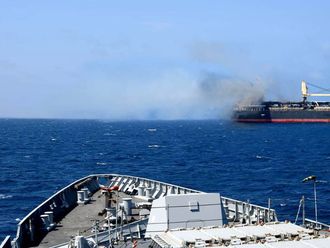
Cairo
Al Qaida’s chief bomb maker, Ebrahim Al Asiri, who was behind the 2009 Christmas Day plot to down an airliner over Detroit and other foiled aviation-related terror attacks, was killed in a US drone strike, Yemeni officials and a tribal leader said on Friday.
The killing of Al Asiri deals a heavy blow to the group’s capabilities in striking western targets and piles pressure on the group that already lost some of its top cadres over the past years in similar drone strikes.
A Yemeni security official said that Al Asiri was dead; a tribal leader and an Al Qaida-linked source also said that he was killed in a US drone strike in the eastern Yemeni governorate of Marib.
The tribal leader said that Al Asiri was struck, along with two or four of his associates, as he stood beside his car.
Al Qaida itself has remained silent about its top bomb maker. Instead of the typical “eulogies” on militant websites, the Yemeni source said the group is trying to hunt down suspected “spies” who might have tipped off the US on his whereabouts leading up to the strike.
The security official spoke on condition of anonymity because he wasn’t authorised to brief reporters. The tribal leader and Al Qaida-linked source requested anonymity fearing for their safety.
The confirmation of Al Asiri’s death follows a UN report this week saying that the 36-year-old Saudi national, who is among US’s top most wanted militants, may have been killed in the second half of 2017.
Al Asiri is believed to have built the underwear bomb that a Nigerian man, Umar Farouk Abdul Mutallab, tried to detonate on a passenger jet over Detroit in December 2009. He is also behind bombs hidden in printer cartridges placed on US-bound cargo jets in 2010.
US intelligence over the past years believed that Al Asiri and his confederates were constantly working to improve their bomb designs so that they could get past airport security.
In July 2014, the Transportation Security Administration banned uncharged mobile phones and laptops from flights to the United States that originated from Europe and the Middle East.
Al Asiri, who studied chemistry in Riyadh, even once placed explosives inside his younger brother’s clothes in a plot to assassinate Saudi Arabia’s interior minister, Mohammad Bin Nayef, in 2009. The brother, Abdullah, died in the explosion while the top US counterterrorism ally was slightly wounded.
The US has long viewed the Al Qaida’s Yemeni branch as its most dangerous affiliate, in part because of Al Asiri’s expertise in explosives. Since 2014, the US has offered $5 million for information leading to his capture. He is thought to have escaped death many times in US drone strikes in Yemen.
Al Asiri’s last known statement was a 2016 audio message threatening Saudi Arabia and the US after the kingdom killed 47 Al Qaida suspects in one of its largest mass executions since 1980.
Vowing to continue battling America, he said at the time that the Saudis would be dealt with in a “different way,” without elaborating.
Wanted by the US, Saudi Arabia and Interpol, Al Asiri fled his native Saudi Arabia for Yemen, along with other militants escaping a crackdown in the kingdom.
Once in Yemen, they merged with local Al Qaida militants who escaped from a Yemeni prison in 2006 to form Al Qaida in the Arabian Peninsula, or AQAP.
Since 2015, Al Qaida has exploited the turmoil in Yemen as a Saudi-led coalition imposed an air, land, and sea blockade and waged war on Yemen’s Iranian-aligned Al Houthis, who gained control of the capital, Sana’a, forcing President Abd Rabbo Mansour Hadi to flee the country.
Amid the chaos, AQAP has expanded its territory, occupied entire cities, looted security camps, banks, and collected taxes from locals.
The UN report on Monday, which first raised allegations that Al Asiri may have been killed, also said that Al Qaida’s global network “continues to show resilience,” with its affiliates and allies much stronger than Daesh in some places, including Somalia, Yemen, South Asia and Africa’s Sahel region.
It added that Yemen’s lack of a strong central government “has provided a fertile environment for” AQAP’s expansion and estimated its strength inside Yemen at between 6,000 and 7,000 terrorists — compared to Daesh militants who only number between 250 to 500.
Al Qaida’s top havens in Yemen are in the central Bayda and eastern Marib provinces. But since 2015, it has suffered heavy losses in leadership as US drone strikes killed off top cadres, including co-founder Nasser Al Wahishi, who was Osama Bin Laden top aide. Veteran Al Qaida leader, Qasem Al Rimi, succeeded Al Wahishi.












